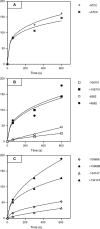Identification and evolution of drug efflux pump in clinical Enterobacter aerogenes strains isolated in 1995 and 2003
- PMID: 18787654
- PMCID: PMC2527680
- DOI: 10.1371/journal.pone.0003203
Identification and evolution of drug efflux pump in clinical Enterobacter aerogenes strains isolated in 1995 and 2003
Abstract
Background: The high mortality impact of infectious diseases will increase due to accelerated evolution of antibiotic resistance in important human pathogens. Development of antibiotic resistance is a evolutionary process inducing the erosion of the effectiveness of our arsenal of antibiotics. Resistance is not necessarily limited to a single class of antibacterial agents but may affect many unrelated compounds; this is termed 'multidrug resistance' (MDR). The major mechanism of MDR is the active expulsion of drugs by bacterial pumps; the treatment of gram negative bacterial infections is compromised due to resistance mechanisms including the expression of efflux pumps that actively expel various usual antibiotics (beta-lactams, quinolones, ...).
Methodology/principal findings: Enterobacter aerogenes has emerged among Enterobacteriaceae associated hospital infections during the last twenty years due to its faculty of adaptation to antibiotic stresses. Clinical isolates of E. aerogenes belonging to two strain collections isolated in 1995 and 2003 respectively, were screened to assess the involvement of efflux pumps in antibiotic resistance. Drug susceptibility assays were performed on all bacterial isolates and an efflux pump inhibitor (PAbetaN) previously characterized allowed to decipher the role of efflux in the resistance. Accumulation of labelled chloramphenicol was monitored in the presence of an energy poison to determine the involvement of active efflux on the antibiotic intracellular concentrations. The presence of the PAbetaN-susceptible efflux system was also identified in resistant E. aerogenes strains.
Conclusions/significance: For the first time a noticeable increase in clinical isolates containing an efflux mechanism susceptible to pump inhibitor is report within an 8 year period. After the emergence of extended spectrum beta-lactamases in E. aerogenes and the recent characterisation of porin mutations in clinical isolates, this study describing an increase in inhibitor-susceptible efflux throws light on a new step in the evolution of mechanism in E. aerogenes.
Conflict of interest statement
Figures


References
-
- Davin-Régli A, Pagès J-M. Regulation of efflux pumps in Enterobacteriaceae: genetic and chemical effectors. 2006. Multiple drug resistance bacteria. 2nd edition, Carlos F. Amabile-Cuevas Editor.
Publication types
MeSH terms
Substances
LinkOut - more resources
Full Text Sources
Other Literature Sources

